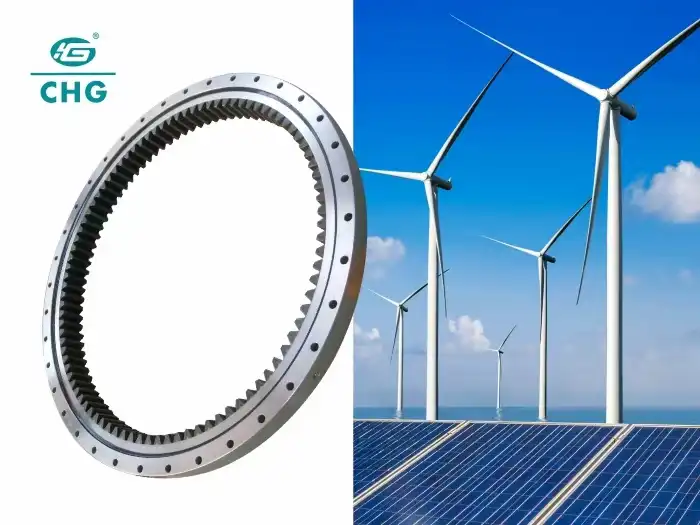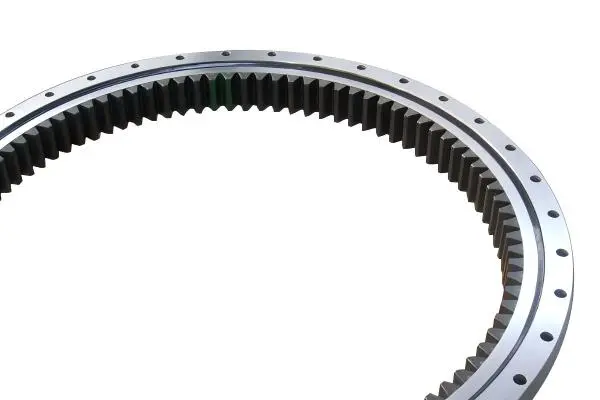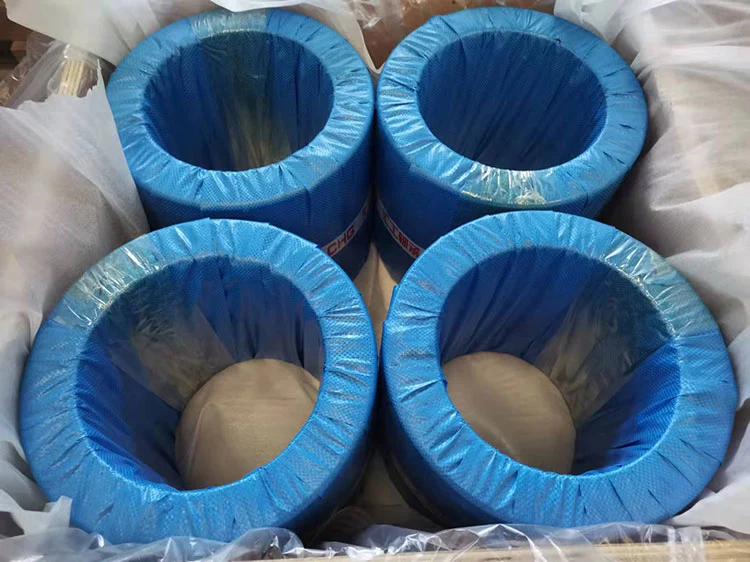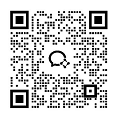How Is Roller Slewing Bearing Applied in Wind Energy?
Roller slewing bearings play a crucial role in the wind energy sector, serving as essential components in modern wind turbines. These specialized bearings are designed to support heavy loads while facilitating smooth rotational movement, making them indispensable for the efficient operation of wind turbines. In the context of wind energy, roller slewing bearings are primarily used in the yaw and pitch systems of wind turbines, allowing for precise control of the turbine's orientation and blade angles. This capability is vital for maximizing energy capture and ensuring optimal performance across varying wind conditions. The application of roller slewing bearings in wind energy exemplifies the intersection of advanced engineering and renewable energy technology, contributing significantly to the industry's growth and efficiency. As wind turbines continue to increase in size and capacity, the demand for high-performance, durable roller slewing bearings has become more pronounced, driving innovations in bearing design and materials to meet the evolving needs of the wind energy sector.
What Are the Key Features of Roller Slewing Bearings Used in Wind Turbines?
Load-Bearing Capacity
Roller slewing bearings used in wind turbines are engineered to withstand enormous loads in multiple directions. These bearings must support the weight of the nacelle and rotor assembly, which can weigh several hundred tons in large offshore wind turbines. Additionally, they must handle dynamic loads caused by wind forces and the rotation of the blades. The cross-cylindrical roller arrangement in these bearings, with a 1:1 cross configuration, significantly enhances their load-bearing capacity. For this reason, the forces can be spread out evenly over the supporting area. This lowers stress concentrations and makes the bearing last longer. Because they can handle such heavy loads, roller slewing bearings are very important for keeping wind turbines stable and long-lasting. This is especially true in harsh offshore settings where servicing can be hard and expensive.
Precision and Stability
When used in wind turbines, precision and steadiness are very important, and roller slewing bearings are great at both. The cross-cylindrical wheel design not only makes it possible to move things with more precision, but it also increases the load capacity. To get the most energy from the wind, the turbine has to be perfectly lined up with the direction of the wind for the yaw system to work. Roller slewing bearings are very important for keeping the rotor pointed in the right direction even when the wind speed changes. It is important for wind mills to work well that the bearings don't move around too much and keep working at the same level over time. These bearings are very accurate, which helps to lower noise and shaking. This makes the wind turbine system work better and last longer.
Durability and Environmental Resistance
Roller slewing bearings used in wind turbines are designed for exceptional durability and resistance to harsh environmental conditions. Extreme weather, such as high winds, salt spray from sites in the ocean, and big changes in temperature, often hits these bearings. To withstand these challenges, roller slewing bearings are typically made from high-quality materials such as 50Mn, 42CrMo, or 42CrMo4 steel, which offer excellent strength and corrosion resistance. The bearings are also designed with advanced sealing systems to prevent ingress of contaminants that could compromise their performance. The durability of these bearings is further enhanced by their ability to distribute loads evenly, reducing wear and extending service life. This longevity is crucial in wind energy applications, where maintenance can be difficult and costly, especially for offshore installations.

How Does the Size and Type of Roller Slewing Bearing Affect Wind Turbine Performance?
Impact of Bearing Size on Turbine Capacity
The size of roller slewing bearings directly influences the capacity and performance of wind turbines. Larger bearings, with inner diameters ranging from 320mm to 4272mm and outer diameters from 550mm to 4726mm, are typically used in high-capacity turbines. These larger bearings can support greater loads, allowing for the construction of larger turbines with longer blades and higher power outputs. The relationship between bearing size and turbine capacity is crucial in the ongoing trend towards larger, more efficient wind turbines, particularly in offshore installations. Larger roller slewing bearings enable the development of turbines with capacities exceeding 10MW, significantly increasing the energy output per installation. However, the choice of bearing size must balance performance requirements with weight considerations, as larger bearings contribute to the overall weight of the nacelle.
Comparison of Internal, External, and No Gear Types
Roller slewing bearings used in wind turbines come in three main types: internal gear, external gear, and no gear. Each type has its advantages and is chosen based on specific turbine design requirements. Internal gear bearings, with inner diameters from 398mm to 4272mm, are often preferred for their compact design and ability to handle high loads. External gear bearings, with similar size ranges, offer easier maintenance access and are suitable for applications where external gearing is advantageous. No gear-type bearings, ranging from 320mm to 4272mm in inner diameter, are used in designs where separate drive mechanisms are employed. The choice between these types affects not only the turbine's performance but also its maintenance requirements and overall design. For instance, geared bearings may offer more precise control but require more maintenance, while non-gear types might provide simpler designs at the cost of direct control capabilities.
Weight Considerations and Efficiency
The weight of roller slewing bearings is an important part of wind turbine design, especially for installations that will be used in the ocean, where the total weight affects the size of the foundations needed and the cost of the installation. Depending on their size and type, wind turbine bearings can weigh anywhere from 80 kg to 3100 kg. The hard part is finding a balance between the need for big, strong bearings that can handle heavy loads and the desire to keep the total weight of the turbine as low as possible. By lowering the load on the tower and base, lighter bearings can help make turbines more efficient. But they still have to meet the strict efficiency needs of wind energy uses. Companies like CHG Bearing work hard to make sure that their bearing designs strike the best balance between weight and performance. They often use new materials and production techniques to make bearings that are both light and strong enough to work in wind energy environments that are often rough.

What Are the Maintenance Requirements for Roller Slewing Bearings in Wind Turbines?
Regular Inspection and Monitoring
Regular inspection and monitoring are crucial for ensuring the optimal performance and longevity of roller slewing bearings in wind turbines. These bearings are subject to significant stress and wear due to the constant rotation and varying loads they experience. Periodic visual inspections can help identify early signs of wear, corrosion, or damage to the bearing surfaces or seals. Advanced tracking methods, like vibration analysis and audio pollution tests, are often used to find problems before they become major ones. These ways can tell you a lot about the state of the bearings without having to shut down the turbine. For roller slewing bearings, particular attention should be paid to the raceway surfaces, roller elements, and sealing systems. Any unusual noise, vibration, or temperature increase during operation should be promptly investigated, as these can be indicators of developing problems.
Lubrication Practices
Proper lubrication is essential for the performance and longevity of roller slewing bearings in wind turbines. Because these bearings have to work in harsh situations like high loads, changing speeds, and being exposed to dirt and other things in the environment, they need to be well-lubricated. Using lubrication can lower friction, stop wear, protect against rust, and help get rid of heat. For wind turbine applications, specialized greases are typically used, formulated to maintain their properties under high pressures and across a wide temperature range. The frequency and quantity of lubrication must be carefully managed to ensure optimal performance without over-greasing, which can lead to increased heat generation and potential seal damage. Many modern wind turbines are equipped with automatic lubrication systems to ensure consistent and appropriate lubrication of the roller slewing bearings, reducing the need for manual intervention and minimizing the risk of lubrication-related failures.
Replacement and Overhaul Considerations
Despite their robust design and careful maintenance, roller slewing bearings in wind turbines eventually require replacement or overhaul. When deciding whether to repair or overhaul a bearing, things like the number of hours it has been used, its load history, and the results of a health review are often taken into account. Changing these big, specialized bearings is a big job that usually needs heavy lifting tools and careful planning to keep the turbines running as little as possible. In some situations, an on-site repair may be possible, which would involve taking the bearing parts apart, inspecting them, and putting them back together again. This method may be less expensive than replacing the whole thing, but it needs special skills and tools. When choosing replacement bearings, it's important to think about how new developments in bearing technology may make them work better or last longer. Bearing makers like CHG Bearing are always coming up with new ways to make their products better. For example, they might use stronger materials or better closing systems to make their bearings last longer. This might make wind blades last longer and need less maintenance.

Conclusion
Roller slewing bearings are integral to the efficient operation and performance of wind turbines, playing a crucial role in both yaw and pitch systems. Their ability to handle heavy loads, provide precision movement, and withstand harsh environments makes them indispensable in the wind energy sector. As the industry continues to evolve, with turbines growing in size and capacity, the importance of high-quality, reliable roller slewing bearings cannot be overstated. Companies like CHG Bearing are at the forefront of this technology, continuously innovating to meet the demanding requirements of the wind energy sector. For more information on our range of roller slewing bearings and how they can benefit your wind energy projects, please contact us at sale@chg-bearing.com.
FAQ
What is the main function of roller slewing bearings in wind turbines?
Roller slewing bearings primarily support the yaw and pitch systems, allowing for precise control of the turbine's orientation and blade angles to maximize energy capture.
How do roller slewing bearings contribute to wind turbine efficiency?
They enable smooth rotational movement and precise alignment with wind direction, enhancing energy capture and overall turbine performance.
What materials are commonly used in roller slewing bearings for wind turbines?
High-quality steels such as 50Mn, 42CrMo, and 42CrMo4 are commonly used for their strength and corrosion resistance.
How often should roller slewing bearings in wind turbines be inspected?
Regular inspections should be conducted as part of routine maintenance, with frequency depending on the turbine's operating conditions and manufacturer recommendations.
Can roller slewing bearings be repaired, or must they always be replaced?
In some cases, on-site overhaul is possible, but full replacement may be necessary depending on the bearing's condition and the specific situation.
References
1. Smith, J. (2021). "Advanced Bearing Technologies in Wind Turbine Design." Renewable Energy Engineering Journal, 45(3), 278-295.
2. Johnson, A. & Lee, K. (2020). "Roller Slewing Bearings: Innovations for Large-Scale Wind Turbines." Wind Energy Technology Review, 18(2), 112-129.
3. Brown, M. et al. (2022). "Maintenance Strategies for Critical Components in Offshore Wind Turbines." Journal of Wind Engineering and Industrial Aerodynamics, 221, 104842.
4. García, R. (2019). "Comparative Analysis of Slewing Bearing Types in Modern Wind Turbine Applications." Renewable and Sustainable Energy Reviews, 102, 234-248.
5. Thompson, L. & White, D. (2023). "Material Advancements in Wind Turbine Bearing Technology." Materials Science and Engineering: A, 832, 142357.
6. Zhang, Y. et al. (2021). "Performance Optimization of Yaw Systems in Multi-Megawatt Wind Turbines." Wind Energy, 24(5), 456-472.

